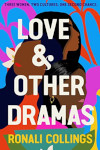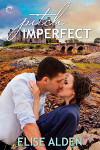Zoë Duncan – The Shifting Pools
Posted 14th July 2017
Category: Reviews Genres: 2010s, Magical Realism, Psychological, Spiritual
Comments Off on Zoë Duncan – The Shifting Pools
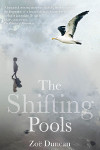
What you see will be.
Publisher: Lightning Books (Eye Books)
Pages: 346
Type: Fiction
Age: Adult
ISBN: 978-1-785-63036-1
First Published: 6th July 2017
Date Reviewed: 14th July 2017
Rating: 4.5/5
Eve’s family lived in a country that was torn by war; in childhood Eve lost them all and suffered further trauma. She moved to England where her well-meaning aunt never stopped trying to cover up any news of the war and never referred to the family. Now in her adult years, Eve is yet to confront her memories and her grief continues as strongly as ever. Her dreams are nightmares and she’s not living anywhere near her potential, but her imagination believes it’s time to heal.
The Shifting Pools is an incredibly moving novel about grief and learning to live despite it. Using many different styles of storytelling, referencing, and ideas, Duncan has created something very different and very special.
This is a slow-moving book. The pace echoes the way utter loss, grief, can take over a life, and Duncan never moves the narrative away from it. Every detail is examined, every thought spoken, in the way it naturally occurs in life, Duncan doing away with the very notion that being repetitive in fiction is bad – she shows well how it is important to delve into grief and give it the time it needs.
One of the first things of note is Duncan’s writing – it’s wonderful. It keeps the pacing constant, it stays steady during tense changes, and it brings something very beautiful to the work. It’s not difficult to fly through this book, despite the subject, and the writing and Duncan’s overall handling of the situation is why. And there is a lot of wisdom here that anyone who has lost someone or been in an awful situation will be able to relate to.
The style of the text as a whole is intriguing. Sections about Eve’s childhood are narrated in the third person. The first person is used for everything else: the ‘present’ as Eve lives through her days and details her thoughts; the vignettes of dreams dotted throughout the book, that explore Eve’s mental state in various imagined situations; the sections in war-torn Enanti, the fantasy world that may or may not be real. And then there are several well-known and not so well-known poems, generally a single verse of each, spread throughout, included in the text as vignettes in their own right. It’s almost of collage, a multi-media project, full of different ideas and voices, and works very well. The term ‘fractured narrative’ comes to mind.
The Shifting Pools uses nature, drawing comparisons between it and the themes of the story, and using its beauty as a way to help Eve. Of note is the character’s name, which, after you have spotted potential influences of other texts and concepts (including Narnia and The NeverEnding Story) does bring forth the question of Eve’s faith. Is there a comparison to be drawn between Eve and the Eden of the Bible? Of Heaven? Quite possibly.
Eve is always at war with herself; as much is said in one of the sections. Her dreams concern various war or battle or prison situations. Of the war that tore apart her family, little is said. Duncan never tells you which war – if any, in reality – she refers to, though there are glimpses of a couple of possibilities; it’s more the basic idea of war that is important.
Reading this book is something of a honour, and a surreal experience. It feels fantastical from the very first page and the amount of research, knowledge, and detail Duncan has included is excellent. She unapologetically runs straight past the border between what we are told is the ‘right’ amount of time and energy to spend grieving to show that the idea of a ‘right’ time never works. This said you can see the thought that’s gone in to getting it right in terms of the reading experience, empathy, and not repeating what has been said unless to view it differently – something that wouldn’t work in many cases but does here.
The only thing that may work against the book is the amount of time spent on the journey in Enanti. It depends on your enjoyment of the fantasy world being included alongside the real world, how much you’re invested in that genre, and how much you personally feels it all relates.
The Shifting Pools is a fantastic reading experience, full of care, love, and, ultimately, hope.
I received this book for review.
Related Books
Amanda Craig – The Other Side Of You
Posted 10th February 2017
Category: Reviews Genres: 2010s, Magical Realism, Social, Spiritual
1 Comment
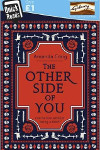
Tale as old as time.
Publisher: Abacus (Little, Brown)
Pages: 100
Type: Fiction
Age: Adult
ISBN: 978-0-349-14172-5
First Published: 2nd February 2017
Date Reviewed: 1st February 2017
Rating: 4.5/5
When Will discovers his aunt has been killed in their flat, he runs away from those who did it. Leaving his estate behind he finds sanctuary in the middle of a residential square, climbing over a fence into a a garden that’s running wild. Dirty, scarred, worried and self-conscious, he begins to learn about gardening and stays hidden, pruning back the plants to bring the place to its former glory. But although he has food enough he lacks the money for other things and so he starts to venture outside the fence.
The Other Side Of You is a novella written for the charity Quick Reads. In keeping with the context and mission, the book sports simple language; it also has bigger print and a hundred pages. The idea is to produce a book that is accessible as well as good for those who want to read but may not have much time.
As you will expect, Craig’s book satisfies these well. The book fits the current recurrence in literature of fairytale retellings; the story is set in present day London with all the realities, hardships, rich spots. It leans on the basic traditional tale for its names – making it easy to see where Craig has chosen to stick as well as deviate in her retelling – as well as the message, but beyond that crafts a different story.
You have to suspend belief to read this book. Craig unapologetically nods to dreams and the almost impossible, blending difficult and achievement in interesting ways, with Will gaining something incredible at the end that in hindsight you see Craig’s workings towards it. It’s the awesome lucky happenstance she seems to say, ‘work at it and things will come’ even if your own is more realistic. Secondly, in terms of realism there is a lovely magical realism/paranormal aspect to the book where Will hears a voice that carries him on, helps him get over impossible fences and so forth that looks to a phenomenon called Third Man Syndrome.
Due to the book’s shortness character development is understandably swift but it’s good, Will beginning with a major lack of knowledge of many things and quickly picking up meanings and concepts. The other characters are devices and this works well. All focus on Will.
The Other Side Of You is a great little book. This slow reader loved it.
I received this book for review.
Related Books
None yet.
Benjamin Wood – The Ecliptic
Posted 5th December 2016
Category: Reviews Genres: 2010s, Art, Commentary, Historical, Magical Realism, Mystery, Psychological
3 Comments

Do not disturb.
Publisher: Scribner (Simon & Schuster)
Pages: 463
Type: Fiction
Age: Adult
ISBN: 978-1-471-12672-7
First Published: 2nd July 2015
Date Reviewed: 28th November 2016
Rating: 4/5
It’s some time in the 1960s or 70s and Elspeth is living at Portmantle, a mansion and grounds on an island near Turkey, a place for the most talented artistically-minded people who are finding creating impossible. Elspeth has been there a number of years – how many exactly she’s not sure, watching, together with similar residents, others come and go whilst her own project evades her. One day a new resident turns up and won’t fall in line with the status quo. And Elspeth starts looking back at what led her to escape the world.
The Ecliptic is a great novel that is at once very different and rather familiar, a book in which the themes are those not often studied in fiction but the overall presentation resonates in a literarily-relatable fashion.
Wood has a lot to say about artists and the creative process; he uses the book as a base, the story as the means by which he dissects various thoughts, conversation, and points of debate, to a highly effective degree.
The mansion and grounds of Portmantle are, of course, a well-placed – literally! – device by which Wood can look at the way art of all types is often created in isolation at the behest of its creator. The solitude and freedom from distractions, from criticism and review, from opinions whether positive or not so. And no one need do their laundry at Portmantle, either. The only chore is, potentially, that of creating. It’s a haven, an artistic utopia.
But like all fictional utopias, things aren’t as perfect as they are first presented to both reader and residents. Wood’s Portmantle is full of rules – meal times, the ability to stay or leave – that replace all the distractions of sociability at home with things that are perhaps even more stifling to those creative minds. Even the rules regarding the journey to the mansion – don’t bring your possessions, disregard your name, take this many moves before a phone call (I’m simplifying it but that’s the basic idea) – are far more controlling than any professor’s university assignment. And no names, thank you. Pick up a new one because no one’s work should be referenced to or put in the context of another’s.
I walked up to the board as though it were a boy I had decided to kiss and streaked a layer of phthalo blue across the surface with a palette knife, the floppy baking kind my mother owned, making an impulsive shape upon the wood. There was no history standing on my shoulders then, no classical references hanging in my head like dismal weather. I was alone, uninfluenced, free to work layers of chalky stolen paint with a big lolloping knife, to smudge with my fingers, pad flat with my fist, thumb, scrape, and scratch. No judgements of technique arose in my mind, because I did not invite them, did not think to. I simply acted, expressed, behaved, made gestures of the knife that seemed unprompted and divined.
It is the way formal education can have an impact on one’s inspiration, raw talent and subsequent work, that is seen as bad. Wood doesn’t say as much directly about the positive impacts of lessons but then he doesn’t need to, it’s shown in the subtext and in references to other ideas.
Another thing that mills in the background, less studied presumably because Portmantle is fiction, is the way that taking time out of life in such a context would impact the eventual reception of the work created. If Elspeth joined Portmantle in the 1960s and has been there a long time without access to the rest of the world – years, decades even – then won’t much of what she creates be irrelevant? The world would have moved on. As much as we like older works we need, crave, new ones. The world is in fact the antithesis of what pianist James Rhodes recently said on the subject of classical music; Rhodes said that people should not write new classical music, that anything new will never match the work of the masters.
But new is surely inspired by a love of the old, is the natural result of that love, and to discourage it would be to lessen the popularity of the old.
It’s interesting that it’s the ‘short-termers’ at Portmantle, those disliked by Elspeth – who actually get work done, that Elspeth and crowd are those no nearer to finishing.
Does Portmantle keep culture away from humanity? One of the possible answers to the mystery of the place is a prison for the highly talented.
The creativity in general, in this book, is exquisite. Yes, there is a lot about the process of painting to the extent you’d think Wood an artist rather than a writer, but there’s a lot for readers of any artistic persuasion. Reams of paragraphs that beg quotation. We should dissect art somewhat but, as Wood’s use of psychiatry shows, dissections should be limited. Some things really aren’t related, they are the result of pure in-the-moment inspiration. Not everything has a meaning behind it and nor should it have to.
There are a couple of aspects that skim the top from this book. The ending – the reveal – which may be considered a bit too been-there-done-that. And the text – Elspeth is in her 20s in the 1960s yet she uses a lot of present day language, colloquialisms from the 21st century – ‘towel off’, ‘unseeable’, for example – rather recent terms and ways of speaking.
So The Ecliptic is imaginative, awesome in its studies and more than worth a read if you’re a creative type, but it does have some draw backs.
One to explore, this book will make you think, want to debate, and quite possibly make you want to create. Get your paintbrush/pen/instrument; you’ll be here for a long time but unlike Elspeth and co you’ll make use of every moment.
This book is shortlisted for the 2016 Young Writer Of The Year Award. I’m on the Shadow Judging Panel.
Related Books
Max Porter – Grief Is The Thing With Feathers
Posted 14th November 2016
Category: Reviews Genres: 2010s, Angst, Commentary, Domestic, Magical Realism, Psychological
5 Comments
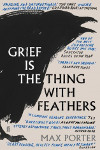
Dealing with sadness (crow).
Publisher: Faber & Faber
Pages: 112
Type: Fiction
Age: Adult
ISBN: 978-0-571-32723-2
First Published: 24th August 2015
Date Reviewed: 9th November 2016
Rating: 4/5
A family in mourning is visited by a crow. Crow brings some havoc with him but he’s also there as Dad gets through the days without his wife – struggling to finish writing his book on Ted Hughes – and as the boys come to terms with life without their mother.
Grief Is The Thing With Feathers is a rather experimental book steeped in literary history. Looking at grief both as a process and in the various guises it takes, it blends prose and poetry together with semi-autobiographical elements – Porter lost his father as a child – to become something very unusual indeed.
There is a lot to this book; it’s difficult to know where to begin. Let’s start with the style: Porter opts to eschew convention, deciding not to choose between poetry, prose, fiction, non-fiction, commentary, study, fully-fledged plot, vignette. His book is the result of a vast mixing pot that is both confusing and compelling. Mind-blowing concepts within the whole compete alongside aspects that are difficult to define. It’s safe to say this book requires a lot of attention.
And a fair bit of knowledge. Whilst the book can just about be read without knowledge of its background subjects, your reading of it will be immensely improved by your having at least a basic idea of the lives and work of those who have influenced Porter. Chief amongst these is the poet Ted Hughes, whose book Crow: From the Life and Songs of the Crow is, not surprisingly, a major factor. Porter’s general interest in Hughes means that any knowledge is useful – and it pays to know about the poet’s relationship with Sylvia Plath.
Porter takes his inspiration for his Crow from Hughes but also from the bird itself. It is the sections written from Crow’s point of view that invite the most bafflement – the sentences are often a mess of words, onomatopoeia-like creations, and a general strangeness pervades. There is the idea of a metaphor – who or what Crow is, and how much he/she/it is related to Hughes’ Crow is a question that spans the entire book. Is this Death? Is this grief itself? Is it, even, Sylvia Plath? And why does Dad see Crow – because it suits Porter or because he’s working on a Hughes commentary?
On the stylistic note, the book uses three narratives – Crow, Dad, and ‘Boys’, the latter of which concerns the two sons but is written from one point of view, potentially to infer that at their young age the boys’ grief could be considered interchangeable, or maybe that their experiences are the same. Sections by the Boys are written in verse and meanings are split over a couple of lines. Much whitespace between narratives as well as lines and sometimes words mean that the book is even shorter than it appears, physically. And in many ways this is a good thing because of the amount of detail and commentary Porter has packed in.
To the stated grief, then; Porter has spared nothing. The book is at its most powerful when it’s examining the forms grief takes and how different people deal with it. Again metaphors and explorations take centre stage, with stereotypes and the idea that one must get over it always lingering nearby.
Take this, the Boys’ reaction to their father calmly coming into their room to tell them their mother has gone:
Where are the fire engines? Where is the
noise and clamour of an event like this?
Where are the strangers going out of their
way to help, screaming, flinging bits of
emergency, glow-in-the-dark equipment
at us to try and settle us and save us?
And this, wherein Dad works through both the metaphorical and literal detritus left in her wake:
She won’t ever use (make-up, turmeric, hairbrush, thesaurus).
She will never finish (Patricia Highsmith novel, peanut butter, lip balm).
And I will never shop for green Virago Classics for her birthday.
I will stop finding her hairs.
I will stop hearing her breathing.
As said, this book requires all your attention. It’s incredibly easy, even with context behind you, to lose your way and it can take work to find yourself again. This is where Porter’s leaving of titbits comes in handy, most noticeably around the middle where comprehension questions, of the English Literature lesson type, are added as part of the narrative.
So Grief Is The Thing With Feathers is hard work but can be very rewarding. But it is also a very unusual beast and fits a specific, niche, category. You have to be happy with the very experimental style.
A difficult book to recommend outright, Porter’s début will intrigue most, delight many, and confuse just as many too and your experience of it won’t necessarily lie in how much you do or don’t know of Porter’s literary interests.
Keep a look out for it, go after it even, and see what you think. It’s quite an experience.
This book is shortlisted for the 2016 Young Writer Of The Year Award. I’m on the Shadow Judging Panel.
Related Books
Helen Oyeyemi – Boy, Snow, Bird
Posted 11th January 2016
Category: Reviews Genres: 2010s, Angst, Domestic, Historical, Magical Realism, Social
8 Comments

Racial divide? What’s that?
Publisher: Picador (Pan Macmillan)
Pages: 306
Type: Fiction
Age: Adult
ISBN: 978-1-447-23713-6
First Published: 27th February 2014
Date Reviewed: 6th January 2016
Rating: 3/5
Boy, a girl, runs away from home, and the abuse from her father. She gets off the bus at the end of the line, moves through a few menial jobs, makes friends. The boy who loved her, who she loved, is forgotten as life takes her towards businessman Arturo and his reputedly perfect daughter, Snow.
Boy, Snow, Bird is based around three girls/women. There isn’t much plot – what little there is isn’t particularly compelling – this is a book written as a study. It’s not bad but beyond the study there’s little to cling to and the ending comes out of left field.
This study, then, forms the subtle backbone of the story. It’s great, full of the sorts of sentences that beg quotation for the meaning they provide because the handling is really very good. Oyeyemi hasn’t a unique viewpoint, but the way she’s written it is wonderful. To sum it up, the book is about race – divisions and broader social issues in the mid 20th century.
To speak of it in long form, the book is about the way this fictional group of black Americans – whose role in the story is to illustrate this particular angle – try to fit into the mostly white society. Strictly speaking, it’s about colour, for example you aren’t told until 1/3 of the way through that particular characters are black, showing the importance of the question, ‘does colour really matter?’ Now of course you may have viewed these characters as black anyway, the lack of detail at the beginning lets you imagine what you want to imagine – but being shown, suddenly, almost, that they are black is what Oyeyemi seems to have been aiming for, not in order to shock you (in case you’ve seen them as white people) but in a literary fiction shocking way, if that makes sense.
The family of Boy, Snow, Bird accomplish their desire to fit in by never acknowledging their colour. That the book is fictional, verging on magical realism, means that they are able to completely ignore their colour in a dismissive way (without actively being dismissive) that furthers the point without the need for the reader to suspend belief. A prime example of the way the family functions is in the scene wherein Boy is asked, by her black in-laws no less, if she slept with a coloured man to produce her mixed-raced daughter.
On the surface Boy, a white character, finds no shame in differences, and never mentions it beyond her discussions with her in-laws.
“Nice try, but I’m not going to stand here while a coloured woman tries to tell me that maybe I’m the one who’s coloured.”
Oyeyemi’s Boy is open, firm, no nonsense; rather than seeming at all superior, she causes Oyeyemi’s study to be more obvious. There is never any sense that Boy is higher or indeed lower because of her whiteness. Or is there? Why did Boy send away her beautiful step daughter?
The above said, you can likely see where ‘Snow’ comes in. Snow is not white but she’s the apple of her relatives’ eyes, a girl supposedly of lighter skin who everyone adores because of it. She fits into the white society, supposedly tricks white people into thinking she’s like them – of course that she’s like them is Oyeyemi’s whole point so the book is a little meta. As says Boy:
Snow’s beauty is precious because it’s a trick. When whites look at her, they don’t get whatever fleeting, ugly impressions so many of us get when we see a coloured girl – we don’t see a coloured girl. The joke’s on us.
In addition to this basic premise, Oyeyemi takes a glance further back to the days of plantations and the differences between ‘house negros’ and the people who worked in the field, the hierarchy there.
Moving on from this subject, it must be said that Boy, Snow, Bird is no fairytale re-telling. Yes there is a beautiful girl called Snow, and yes her stepmother sends her away, and there are mirrors, but beyond that there is nothing. If you want to read an exceptional dialogue of race relations and fitting in, give this book a try, but if you’re looking for a retelling go elsewhere.
Mirrors in this book suggest beauty, look at beauty and identity. What Boy sees in the mirrors she’s obsessed with point to many issues she has and it is primarily here that the book shows the distinction between fantasy and magical realism. It’s a fair subject and an interesting look at both the outer world and the inner world – what one sees in themselves, what others see, and what can cloud perception.
Where Boy, Snow, Bird fails, then, is in the way it’s written. It’s not the words – Oyeyemi writes beautifully – it’s the execution. The addition of characters that don’t aid the plot. Letters when prose and actually meeting the characters would’ve been better. An ending that seems thrown in for good measure. A lack of detail and a general confusion, different to the planned racial confusion, and distance between reader and characters, make it difficult to lose yourself in the text and work out where the characters are, what time they’re in, what’s going on, and what the book is about. Unfortunately the question ‘what does this book want to be?’ can be applied here.
It’s hard to say why the ending was written. In the last few pages Oyeyemi starts up on a completely new issue that is interesting in itself but has no baring on the rest of the book – or at least it shouldn’t; Oyeyemi sort of jams it in. If it is an attempt to provide a reasoning for abuse it fails miserably because it’s not a very nice thing to use in comparisons, at least not in the way it’s been written. If it’s to try and show that the author hasn’t forgotten the set up, it really wasn’t needed here. And if it’s some sort of girls in it together idea it just falls flat. (This issue warrants the use of an extra genre tag but I’m not going to use it because the book does not do that tag and its readership any favours.)
If Boy, Snow, Bird had been a novella or short story, more focused, it would’ve been excellent. As it is although there’s much to like about it on a historical and intellectual level there’s just as much that isn’t so good and as such it’s difficult to fully recommend it. If there was ever a chapter book to dip into, this one is it.












